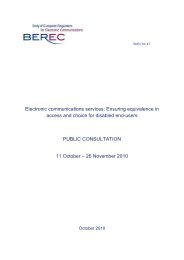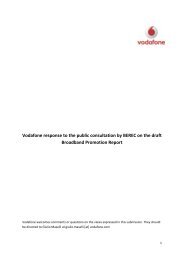BEREC REPORT ON IMPACT OF FIXED-MOBILE ... - berec - Europa
BEREC REPORT ON IMPACT OF FIXED-MOBILE ... - berec - Europa
BEREC REPORT ON IMPACT OF FIXED-MOBILE ... - berec - Europa
You also want an ePaper? Increase the reach of your titles
YUMPU automatically turns print PDFs into web optimized ePapers that Google loves.
BoR (11) 54<br />
Scoreboard 2011report showed that growth in fixed broadband access in 2010 was the<br />
lowest since 2003.<br />
In Q4 2009, the E-communication household survey indicated that 4%of households<br />
with Internet access only use mobile networks to access the Internet 26 . The majority<br />
(85%) of those using just the mobile network to gain access to the Internet feel that this<br />
meets the needs of everyone in the household. For these households, which according<br />
to the E-communication household survey still represent a relatively narrow segment,<br />
mobile Internet access can potentially be regarded as a substitute for fixed line Internet<br />
access.<br />
However, as discussed earlier, it may also be the case that some of these mobile-only<br />
households represent a new source of market demand for which mobile internet suits a<br />
particular need.<br />
4.2.2. Local differences<br />
Broadband access<br />
As for voice, the trend for FMS of data services may differ significantly depending on<br />
the country considered. Without prejudice to a particular country case analysis, these<br />
local differences can be caused by:<br />
Different levels of mobile broadband adoption;<br />
Different percentage of mobile data-only households among households<br />
connected to the Internet.<br />
Use of the mobile phone network (via an Internet card or USB modem that is plugged<br />
into the computer or a computer connected to the Internet via a mobile phone or<br />
directly via the mobile phone itself) to connect to the Internet at home has shown an<br />
increase since winter 2009 (+3 percentage points) 27 . This type of access is most<br />
common in Finland, where around three in ten access the Internet this way (29%).<br />
Conversely, in Belgium (3%), France (3%), Luxembourg (3%) and Malta (3%) use is<br />
comparatively low (cf. Annex 1).<br />
26 E-communication household survey (2010) – “Most households (six out of ten) are connecting to the mobile network<br />
via an Internet card or USB modem that is plugged into the computer. A third is connecting through a mobile phone and<br />
only one in seven are using a computer connected to the Internet via a mobile phone.”<br />
27 Source – E-communication household survey (2011).<br />
Remark: “the survey tackles two different issues regarding mobile Internet connections. On the one hand the results<br />
presented in this chapter on the usage of the mobile phone network to connect to the internet at home and on the other<br />
hand the mobile subscriptions allowing connecting to the Internet. It is not because people have a mobile phone<br />
allowing them to surf on the Internet that they mainly use this device to connect to the Internet when they are at home.”<br />
21





